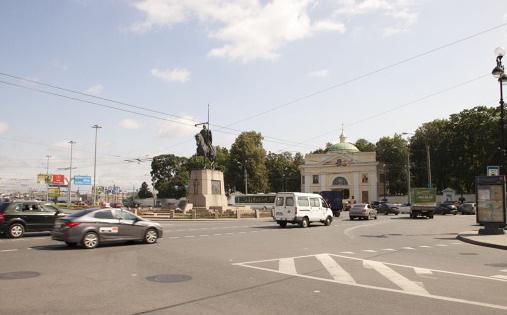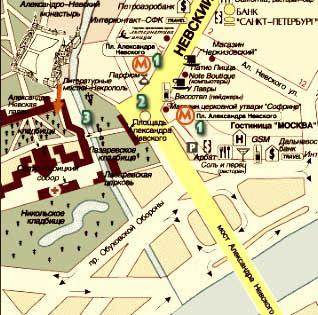Grand Duke Alexander Nevsky is the spiritual patron of St. Petersburg. The fate of this great man is invisibly tied to the fate of the city. It was Prince Alexander who first fought with the enemy on the banks of the Neva River, it was he who managed to free this land from enemy invaders, where then, on the orders of Peter the Great, they erected a great city - St. Petersburg.
Alexander Nevsky Monastery
Alexander Nevsky Square is a significant place for the city. And the history of the square goes back to the distant Peter's era. In the hot summer of 1710, Peter I, circling his possessions, stopped on the picturesque bank of the Chernaya River (today it is the Monastyrka River). This place was not only amazingly beautiful, but also, according to legend, it was here that Grand Duke Alexander Nevsky defeated the Swedes in the distant 1240. Therefore, in memory of this feat of the Russian people, Peter decided to build the Alexander Nevsky Monastery in this place. Peter considered himself the successor of the work of Alexander Nevsky (whom he declared the spiritual patron of the city) in his desire to approach the shores of the Baltic Sea. And therefore, the center of the new Russian capital was to become the Alexander Nevsky Lavra. And in 1722 they laid the first stone in the construction of the complex. But because of the poorly designed building, huge cracks went along the walls of the monastery. By order of Peter, the walls were dismantled to the ground, and the work was curtailed. And only in 1774 the construction of the monastery and laurels resumed.

History of the construction of the square
After the construction of the Alexander Nevsky Monastery was completed, there was no square in front of the building as such. It was not a very well-groomed space, which Empress Catherine II decided to ennoble. And despite the fact that the main street of the city, Nevsky Prospekt, went to the monastery complex, this place was notorious. Initially, barns, houses of citizens, almshouses and even brothels were adjacent to the square of the Alexander Nevsky Monastery almost densely. The townspeople were afraid to walk here in the dark, because they often became victims of robbers, and, according to legend, there were a huge number of rats here. The space in front of the monastery was not lit at all; dirt reigned around. By order of the empress, nearby buildings were demolished and made a transport interchange. The construction and design of the square was entrusted to Starov Ivan Egorovich. The architect designed the area not of a semicircular shape, as was customary at that time, but of a drop-shaped one. The space behind the Holy Gates had a regular round shape, and Starov combined these two squares into one complex. Thanks to this idea of the author, a smooth transition was made from the Trinity Temple to the axis of Nevsky Prospekt.

Area in the pre-war years
In the early twenties, Alexander Nevsky Square was renamed Red. She had such a name until 1952. It should be noted that in the early twenties, like several centuries ago, the high architectural style coexisted with poverty and squalor. Alexander Nevsky Square was surrounded by brick barns in which grain was stored, the area was still not lit, there was no embankment.
Post-war area
During the war, Leningrad was subjected to mass bombing. The city was in poor condition. In 1947, it was decided to reconstruct Alexander Nevsky Square (the map is presented in the article). Architects proposed building two identical buildings in the neoclassical style on opposite sides of the square. In their opinion, this style should have been combined with the Alexander Nevsky monastery complex. But the buildings turned out to be different, although they were very much alike. Now it is at home No. 175 and No. 184. And in 1965, traffic was opened along the Alexander Nevsky Bridge. This made it possible to connect the two banks and open a direct exit to Nevsky Prospekt. During these years, the embankment was designed, a modern transport interchange was built. Also on pl. Alexander Nevsky built the Moscow Hotel, the architects of which are Shcherbin V.N., Goldgor V.S., Varshavskaya L.K. The metro station Ploshchad Aleksandra Nevsky-2 was opened. Old warehouses were demolished.

Alexander Nevsky Square (St. Petersburg) today
The last significant interventions in the reconstruction of the area were at the beginning of the 2000s. So, in 2002, on the day of the Great Victory, a monument to Alexander Nevsky was unveiled . The author of the project was the sculptor V. G. Kozenyuk. He worked on his creation for more than thirty years. According to the artist, the monument was to be a single ensemble with the Bronze Horseman. Both monuments are turned in one direction, but one is at the beginning, and the other at the end of Nevsky Prospect. In 2005, a bas-relief with scenes from the Battle of the Ice was erected on the pedestal of the monument to Alexander Nevsky . And in 2007, the reconstruction of the Moscow Hotel began. Alexander Nevsky Square (St. Petersburg) has changed. In 2008, the eponymous shopping center was opened in the courtyard of the hotel.
Metro station “Alexander Nevsky-2 Square”
This station is located on the Right Bank line between Novocherkasskaya and Ligovsky Prospekt stations. It was opened in 1985. The above-ground construction of the building of the metro station “Ploshchad Aleksandra Nevskogo” is a five-story metro industrial and household complex. The lobby of the station was designed by architects Romashkina-Timanova N.V., Getskina A.S. The lobby forms a semicircular volume of the building. The walls of the station are decorated with large stained-glass windows. Thanks to them, the internal space is visually increased. The lobby walls are faced with Saarem dolomite, light marble was also used for wall decoration, and the floor is covered with Karelian granite. The ceiling is a dome with radially folded reinforced concrete structures. The diameter is about twenty-eight meters. The underground part is at a depth of 60 meters. It was built according to the project of architects Shcherbin V.N., Buldakova G.N. The inner space forms a colonnade in two rows. These columns have bevels at the bottom. The basement of the track walls is finished with polished granite. The rest is lined with aluminum plates in the form of armor scales. At the station, at the end of the building, there is an empty niche. According to the authors, it was supposed to have a statue of Alexander Nevsky in it. First, the author of the sculpture was to be Goreva E.V., then the sculptor M. Anikushkin. But these plans were never destined to happen.
How to get there
Alexander Nevsky Square is located at the entrance to the Alexander Nevsky Lavra, at the end of Nevsky Prospect, onto which the Alexander Nevsky-2 Square metro station goes.